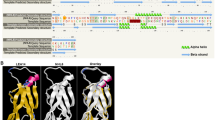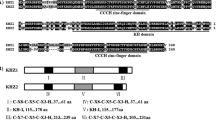Abstract
RING zinc-finger proteins play important roles in the regulation of development in a variety of organisms. In the plant kingdom, few genes encoding RING zinc-finger proteins have been documented with visible effects on plant growth and development. A novel gene, RIE1, encoding a RING-H2 zinc-finger protein was identified in Arabidopsis thaliana and is characterized in this paper. RIE1 encodes a predicted protein product of 359 amino acids residues with a molecular mass of 40 kDa, with a RING-H2 zinc-finger motif located at the extreme end of the C-terminus. Characterization of a Dissociation (Ds) insertion line (SGT4559) and a T-DNA insertion line (SRIE1) demonstrated that disruption of RIE1 is embryo-lethal. SGT4559 heterozygous plants produced seeds with embryo development arrested from globular to torpedo stages. Some mutant seeds were rescued by embryo culture, and the mutant (rie1) plants seemed to grow normally compared to wild-type plants, except that the mutants produced only abnormal seeds. However, RIE1 was expressed in different tissues throughout the whole plant as revealed by northern blot analysis and gene fusion assay of RIE1 promoter with the β-glucuronidase (GUS) gene. Our results indicated that RIE1 plays an essential role in seed development.
Similar content being viewed by others
References
Bechtold, N., Ellis, J. and Pelletier, G. 1993. In planta Agrobacterium mediated gene transfer by infiltration of adult Arabidopsis thaliana plants. C.R. Acad. Sci. Paris Sci. Vie/Life Sci. 316: 1194–1199.
Borden, K.L.B. 2000. RING domains: master builders of molecular scaffolds? J. Mol. Biol. 295: 1103–1112.
Borden, K.L.B. and Freemont, P.S. 1996. The RING finger domain: a recent example of a sequence-structure family. Curr. Opin. Struct. Biol. 6: 395–401.
Buchanan-Wollaston, V. 1997. The molecular biology of leaf senescence. J. Exp. Bot. 48: 181–199.
Chaudhury, A.M., Koltunow, A., Payne, T., Luo, M., Tucker M. R., Dennis, E.S. and Peacock, W.J. 2001. Control of early seed development. Annu. Rev. Cell Dev. Biol. 17: 677–699.
Chomczynski, P. and Sacchi, N. 1987. Single-step method of RNA isolation by acid guanidinium thiocyanate-phenol-chloroform extraction. Anal. Biochem. 162: 156–159.
Ciechanover, A. 1998. The ubiquitin-proteasome pathway: on protein death and cell life. EMBO J. 17: 7151–7160.
Ciechanover, A., Orian, A. and Schwartz, A.L. 2000. Ubiquitinmediated proteolysis: biological regulation via destruction. BioEssays 22: 442–451.
Deng, X.W., Matsui, M., Wei, N., Wagner, D., Chu, A.M., Feldmann, K.A. and Quail, P.H. 1992. COP1, an Arabidopsis regulatory gene, encodes a protein with both a zinc-binding motif and a Gβ homologous domain. Cell 71: 791–801.
Freemont, P.S., Hanson, I.M., Trowsdale, J. 1991. A novel cysteinerich sequence motif. Cell 64: 483–484.
Freemont, P.S. 2000. Ubiquitination: RING for destruction. Curr. Biol. 10: R84–R87.
Freemont, P.S. 1993. The RING finger: a novel protein sequence motif related to the zinc finger. Ann. NY Acad. Sci. 684: 174–192.
Gan, S. and Amasino, R.M. 1997. Making sense of senescence: molecular genetic regulation and manipulation of leaf senescence. Plant Physiol. 113: 313–319.
Goldberg, R.B., De Paiva, G. and Yadegari, R. 1994. Plant embryogenesis: zygote to seed. Science 266: 605–614.
Gray, W.M., Hellmann H., Dharmasiri, S. and Estelle, M. 2002. Role of the Arabidopsis RING-H2 protein RBX1 in RUB modi-fication and SCF function. Plant Cell 14: 2137–2144.
Haas, A.L. and Siepmann, T.J. 1997. Pathways of ubiquitin conjugation. FASEB J. 11: 1257–1268.
Haas, B.J., Volfovsky, N., Town, C.D., Troukhan, M., Alexandrov, N., Feldmann, K.A., Flavell, R.B., White, O. and Salzberg, S.L. 2002. Full-length messenger RNA sequences greatly improve genome annotation. Genome Biol. 3(6): 0029.1–0029.12.
Hochstrasser M. 1996. Ubiquitin-dependent protein degradation. Annu. Rev. Genet. 30: 405–439.
Jensen, R.B., Jensen, K.L., Jespersen, H.M. and Skriver, K. 1998. Widespread occurrence of a highly conserved RING-H2 zinc finger motif in the model plant Arabidopsis thaliana. FEBS Lett. 436: 283–287.
Jefferson, R.A. 1987. Assaying chimeric genes in plants: the GUS gene fusion system. Plant Mol. Biol. Rep. 5: 387–405.
Jefferson, R.A., Kavanagh, T.A. and Bevan, M.W. 1987. GUS fusions: β-glucuronidase as a sensitive and versatile gene fusion marker in higher plants. EMBO J. 6: 3901–3907.
Jiang, L., Philips, T.E., Rogers, S.W. and Rogers J.C. 2000. Biogenesis of the protein storage vacuole crystalloid. J. Cell Biol. 150: 755–769.
Joazeiro, C.A.P., Wing, S.S., Huang, H.K., Leverson, J.D., Hunter, T. and Liu, Y.C. 1999. The tyrosine kinase negative regulator c-Cbl as RING-type, E2-dependent ubiquitin-protein ligase. Science 286: 309–312.
Kyte, J. and Doolittle, R.F. 1982. A simple method for displaying the hydropathic character of a protein. J. Mol. Biol. 157: 105–132.
Laity, J.H., Lee, B.M. and Wright, P.E. 2001. Zinc-finger proteins: new insights into structural and functional diversity. Curr. Opin. Struct. Biol. 11: 39–46.
Lechner, E., Goloubinoff, P., Genschik, P. and Shen, W.H. 2002. A gene trap Dissociation insertion line, associated with a RING-H2 finger gene, shows tissue specific and developmental regulated expression of gene in Arabidopsis. Gene 290: 63–71.
Lorick, K.L., Jensen, J.P., Fang, S., Ong, A.M., Hatakeyama, S. and Weissman, A.M. 1999. RING fingers mediate ubiquitinconjugating enzyme (E2)-dependent ubiquitination. Proc. Natl. Acad. Sci. USA 96: 11364–11369.
Martínez-García, M., Garcidueñas-Piña, C. and Guzmán, P. 1996. Gene isolation in Arabidopsis thaliana by conditional overexpression of cDNAs toxic to Saccharomyces cerevisiae: identi-fication of a novel early response zinc-finger gene. Mol. Gen. Genet. 252: 587–596.
Matsuda, N. and Nakano, A. 1998. RMA1, an Arabidopsis thaliana gene whose cDNA suppresses the yeast sec15 mutation, encodes a novel protein with a RING finger motif and a membrane anchor. Plant Cell Physiol. 39: 545–554.
Matsuda, N., Suzuki, T., Tanaka, K. and Nakano, A. 2001. Rma1, a novel type of RING finger protein conserved from Arabidopsis to human, is amembrane-bound ubiquitin ligase. J. Cell Sci. 114: 1949–1957.
Meinke, D.W. 1994. Seed development in Arabidopsis thaliana. In: E.M. Meyerowitz and C.R. Somerville (Eds.) Arabidopsis, Cold Spring Harbor Laboratory Press, Plainview, NY, pp. 253–295.
Meinke, D.W. 1995. Molecular genetics of plant embryogenesis. Annu. Rev. Plant Physiol. Plant Mol. Biol. 46: 369–394.
Meinke, D.W. 1991. Perspectives on genetic analysis of plant embryogenesis. Plant Cell 3: 857–866.
Molnár, G., Bancos, S., Nagy, F. and Szkeres, M. 2002. Characterization of BRH1, a brassinosteroid-responsive RING-H2 gene from Arabidopsis thaliana. Planta 215: 127–133.
Nakai, K. and Kanehisa, M. 1992. A knowledge base for predicting protein localization sites in eukaryotic cells. Genomics 14: 897–911.
Parinov, S., Sevugan, M., Ye, D., Yang, W.C., Kumaran, M. and Sundaresan, V. 1999. Analysis of flanking sequences from Dissociation insertion lines: a database for reverse genetics in Arabidopsis. Plant Cell 11: 2263–2270.
Potuschak, T., Stary, S., Schlögelhofer, P., Becker, F., Nejinskaia, V. and Bachmair, A. 1998. PRT1 of Arabidopsis thaliana encodes a component of the plant N-end rule pathway. Proc. Natl. Acad. Sci. USA 95: 7904–7908.
Quirino, B.F., Noh, Y.S., Himelblau, E. and Amasino, R.M. 2000. Molecular aspects of leaf senescence. Trends Plant Sci. 5: 278–282.
Sambrook, J., and Fritsch, E.F. 2001. Molecular Cloning: A Laboratory Manual, 3rd ed. Cold Spring Harbor Laboratory Press, Plainview, NY.
Saurin, A.J., Borden, K.L.B., Boddy, M.N. and Freemont, P.S. 1996. Does this have a familiar RING? Trends Biochem. Sci. 21: 208–214.
Schneider, T., Dinkins, R., Robinson, K., Shellhammer, J. and Meinke, D.W. 1989. An embryolethal mutant of Arabidopsis thaliana is a biotin auxotroph. Dev. Biol. 131: 161–167.
Schwechheimer, C., Serino, G., Callis, J., Crosby, W.L., Lyapina, S., Deshaies, R.J., Gray, W.M., Estelle, M. and Deng, X.W. 2001. Interactions of the COP9 signalosome with the E3 ubiquitin ligase SCFTIR1 in mediating auxin response. Science 292: 1379–1382.
Shellhammer, J. and Meinke, D.W. 1990. Arrested embryos from the bio1 auxotroph of Arabidopsis contain reduced levels of biotin. Plant Physiol. 93: 1162–1167.
Sundaresan, V., Springer, P., Volpe, T., Haward, S., Jones, J.D., Dean, C., Ma, H. and Martienssen, R. 1995. Patterns of gene action in plant development revealed by enhancer trap and gene trap transposable elements. Genes Dev. 9: 1797–1810.
Thomas, T.L. 1993. Gene expression during plant embryogenesis and germination: an overview. Plant Cell 5: 1401–1410.
Torii, K.U., McNellis, T.W. and Deng, X.W. 1998. Functional dissection of Arabidopsis COP1 reveals special roles of its three structural modules in light control of seedling development. EMBO J. 17: 5577–5587.
Torii, K.U., Stoop-Myer, C.D., Okamoto, H., Coleman, J.E., Matsui, M. and Deng, X.W. 1999. The RING finger motif of photomorphogenic repressor COP1 specifically interacts with the RING-H2 motif of a novel Arabidopsis protein. J. Biol. Chem. 274: 27674–27681.
Tyers, M. and Willems, A. R. 1999. One ring to rule a superfamily of E3 ubiquitin ligases. Science 28: 603–604.
Uwer, U., Willmitzer, L. and Altmann, T. 1998. Inactivation of a glycyl-tRNA synthetase leads to an arrest in plant embryo development. Plant Cell 10: 1277–1294.
Wu, Y., Haberland, G., Zhou, C. and Koop, H.U. 1992. Somatic embryogenesis, formation of morphogenetic callus and normal development in zygotic embryos of Arabidopsis thaliana in vitro. Protoplasma 169: 89–96.
Xie, Q., Guo, H.S., Dallman, G., Fang, S., Weissman, A.M., Chua, N.H. 2002. SINAT5 promotes ubiquitin-related degradation of NAC1 to attenuate auxin signals. Nature 419: 167–170.
Xu, R.Q., Tomooka, N., Vaughan, D.A. 2000. AFLP markers for characterizing the Azuki bean complex. Crop Sci. 40: 815–823.
Zou, J., and Taylor, D.C. 1997. Cloning and molecular characterization of an Arabidopsis thaliana RING zinc finger gene expressed preferentially during seed development. Gene 196: 291–295.
Author information
Authors and Affiliations
Corresponding author
Rights and permissions
About this article
Cite this article
Xu, R., Quinn Li, Q. A RING-H2 zinc-finger protein gene RIE1 is essential for seed development in Arabidopsis . Plant Mol Biol 53, 37–50 (2003). https://doi.org/10.1023/B:PLAN.0000009256.01620.a6
Issue Date:
DOI: https://doi.org/10.1023/B:PLAN.0000009256.01620.a6




